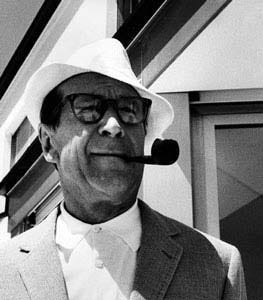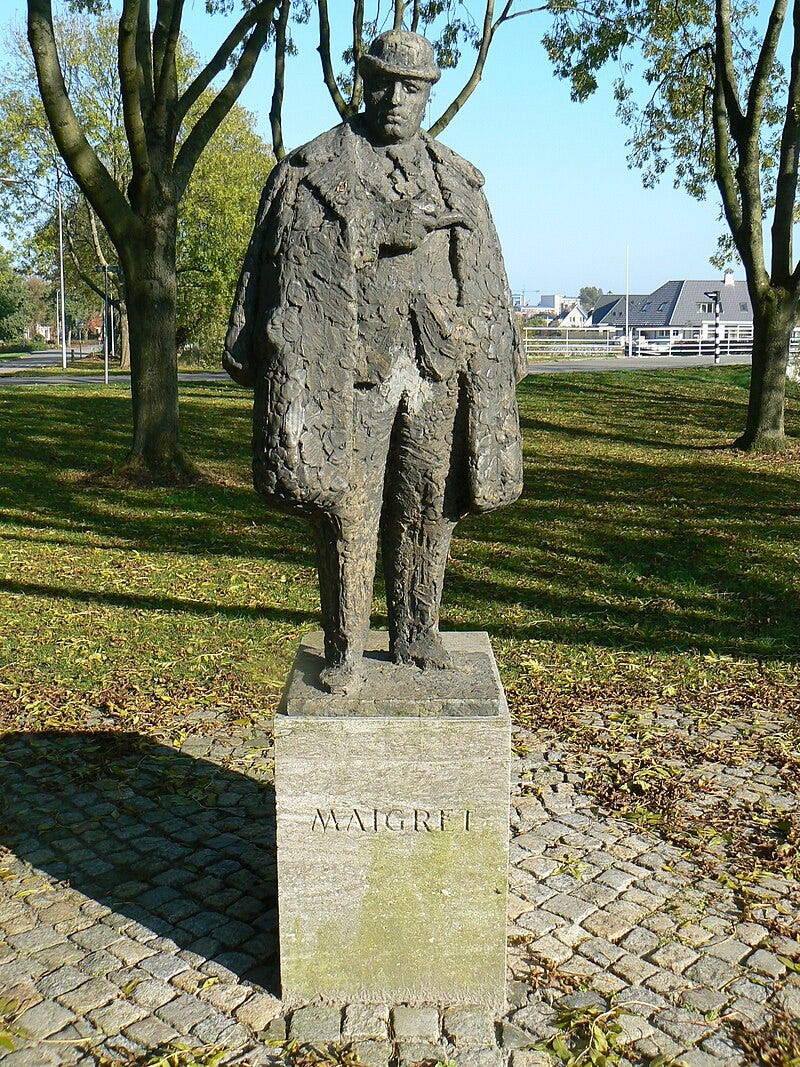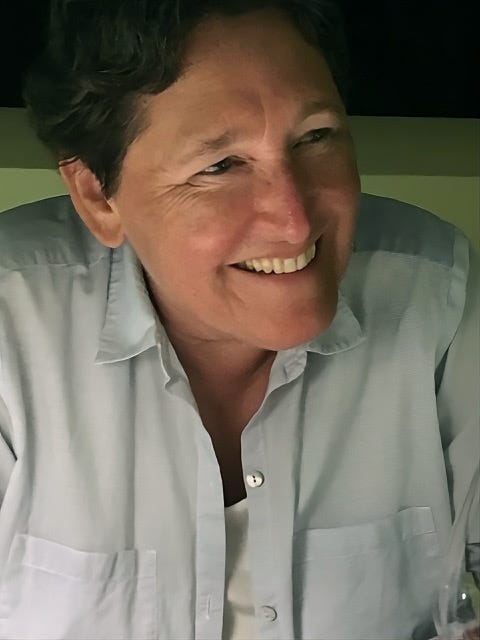Why I ❤️ Georges Simenon, creator of the detective Jules Maigret
The Books We ❤️ Club welcomes Martine Proctor of The Roll Top Desk
I can’t remember how I first encountered Martine Proctor on Substack, we don’t seem to even have much overlap in our reading, but whether by chance or fate, I’ve always felt a unique kinship for her quiet personal style which masks the writing chops of a killer.
I have never met a writer who publishes so prolifically in journals and magazines—every single post, she’s announcing a story here and there. Her genre is mainly crime/mystery fiction, with some speculative and horror thrown in when the mood suits her.
Our literary kinship must derive in part from my longstanding love of two detectives: Sherlock Holmes and Hercule Poirot. Not that I’ve ever read Agatha Christie—my particular affinity is for the rather adorable portrayals of the famous Belgian detective by Peter Ustinov and David Suchet. I have read all of the Sherlock Holmes stories and novellas, but never an actual Christie novel.
So it is with great pleasure that I’m welcoming Martine to tell us all about the Belgian author, Georges Simenon, creator of the other great continental detective—the one undoubtedly more beloved in French-speaking countries—Jules Maigret.
We hope you will be equally pleased.
I highly recommend M.E. Proctor’s Love You Till Tuesday—my Goodreads review:
Great new detective on the crime fiction scene! Declan Shaw is nobody's fool, and this debut novel from stellar short story writer M.E. Proctor is a fast and gripping read. Looking forward to many more appearances.
And I loved the ARC of her upcoming Catch Me On A Blue Day. Links and details at the end.
Happy reading! ~ MTF
The Books We ❤️ Club—the book club you don’t actually have to read the book, leave the house, or even change out of your jammies to enjoy—as writers sing the praises of books that reach into our hearts.
We invite you to add your own reactions, insights, and ideas in the Comments for an impromptu book club session. Share your favorite quotes, characters, moments, and surprises in discussion with other passionate readers.
(And if you’d like to feature your favorite book in a future edition, DM me.)
NEXT TIME: “Why I ❤️ O Caledonia by Elspeth Barker” with yours truly,
Why I ❤️ Georges Simenon
by of
Asking writers what book or author influenced them is a classic and fair question. Yet it makes me prickly. I have a really hard time making a choice. How many books and stories have I read, from how many authors? Should I pick the books I reread often, or the author who takes the most space on my shelves?
I’ve had so many reading crushes …
As I pondered what sensible answer to give to Troy’s question, I wondered if I was looking at this the wrong way.
I’ve read a metric ton of Stephen King and it never inspired me to write a horror novel. I’ve written a bunch of short stories that flirt with the genre, though, and one of them, Black and Tan (in the Family and Other Ailments collection), has a definite King flavor. I didn’t realize what I’d done until a reader pointed the similarities to me. So, scratch that.
At one time in my life I went on a James Ellroy book bender. He had an impact on my writing, all right. Thanks to him, I tend to use too many sentence fragments and I have to watch it. Rat-tat-tat writing gets tiresome. Clipped sentences get boring. A case of too much of a good thing. There, I did it again: fragment!
To find true influence, I have to dig a lot deeper and go way back in time.
I can’t remember who said that childhood provides an infinite source of inspiration. Probably Ray Bradbury, who mined that memory deposit extensively. I believe the same can be said about books that leave a persistent impression on a writer. The stuff we read when our brains are still uncluttered has to mark us more deeply than what we pluck later when we’re battling constant data overload.
It doesn’t mean that new discoveries can’t make me swoon. I picked up Tana French’s books a few years ago and she bowled me over. But does she influence my writing? Probably not. My mind works a certain way, my thoughts develop along certain lines that are uniquely mine. Falling in love with a writer and their style won’t radically change any of that. It can’t, it’s too late. I’m a grown-up now.
Which brings me to Georges Simenon.
I was a lucky girl. I grew up in a house full of books and nobody ever told me what I could and couldn’t read. That extended beyond the family home. When we went to visit relatives or friends, when the adults chatted and it was too dark to run outside with the cousins, you would find me in a corner buried in a paperback or a comic book I grabbed off a shelf (I still feel uneasy entering a house without books. Drat, no escape!).
My parents must have assumed that whatever was displayed in plain view was probably okay, or I wouldn’t understand it anyway–I read Mickey Spillane at twelve (courtesy of an uncle who was a fan), some of it must have sailed way over my head.
Not so with Simenon. He enthralled me from the get-go and left long-lasting memories. I have revisited the man’s massive oeuvre regularly over the years. What started with my dad’s battered paperback collection, continued with the occasional flea market find, and has now come full circle with the Omnibus edition (in French) of all the Maigret books and the Romans Durs (the literary hard novels). I don’t have them all yet but I’m getting there.
When I decided to focus on writing crime, after spending twenty years on a science-fiction saga, the man must have been peeking over my shoulder and tugging at my subconscious.
Simenon and I are from the same part of the world. Brussels, for me. Liège, for him. We are, two generations remote, products of the same culture. There’s a strong literary tradition in our northern lands, born from the gray and the gloom. It rains a lot and people are rather reserved. Simenon’s books are mostly set in France (he moved to Paris when he was nineteen), but the closeness, the reticence that dominate his novels are what I inhaled as a kid. The atmosphere was familiar. I knew these kinds of people who kept their inner thoughts to themselves, part propriety, part shyness. Keepers of secrets.
And there’s the writing style itself. Simenon started cranking out novels a hundred years ago. You wouldn’t guess it by the way he chisels a sentence. His style is plain, straight, stripped down to the bare bones. There isn’t a speck of dust or a strand of cobweb between his lines.
He taught me that you don’t need complexity to be effective. And that simplicity is deceptive. To prepare for this post, I did a deep dive into Simenon’s early books, when he started writing under his real name instead of pseudonyms. He was twenty-seven when the first Maigret book came out, with a career as a journalist and novelist already behind him.
In The Crime at Lock 14 (also known as The Carter of “La Providence”) he describes a local café. It’s a watering hole for the people making a living on a canal—barge folks, carters, lock operators. The place is drab. Brown and yellow walls, brown toile cirée (wax cloth) on the tables, country food. But different than what you would expect in a regular rural setting. It smells of horses, stables, leather harnesses, tar, diesel, and grocery supplies. The café is the heart of a small, somewhat transient, river community. The place feels alien to Maigret, a cop from Paris, a stranger who doesn’t know the customs and the vocabulary. The story is set in Champagne. Hills, rivers, canals, horses pulling barges, boats waiting their turn while the lock fills up and empties. Picturesque? Not at all. It’s winter, bleak, and it rains constantly. Mud is everywhere, except on the white suede shoes of the strangled victim.
Here’s a quote.
“Et la pluie tombait sans trêve sur un vilain paysage. A gauche et à droite, l’horizon était borné par des collines crayeuses, aux traînées blanches et noires, où les vignes, à cette saison, n’apparaissaient que comme des croix de bois dans un cimetière du front.”
— Tout Maigret T. 1 by Georges Simenon
It translates as follows (courtesy of Bing, I slightly amended the end.)
“And the rain fell incessantly on an ugly landscape. To the left and to the right, the horizon was bounded by chalky hills, with white and black streaks, where the vines, at that season, were like wooden crosses in a cemetery at the front.”
These powerful descriptive snippets, dropped casually in the middle of a crime story, are what stuck with me. I might not remember the plot, but I will remember how the book made me feel.
The novel that has stayed with me for the longest time is L’Affaire Saint-Fiacre (sometimes translated as Maigret Goes Home or The Saint-Fiacre Affair). It’s a strange story that mixes class tension and childhood memories. Maigret, now a commissaire with the national police, returns to the village of his birth. The matriarch of the Saint-Fiacre family found an ominous note in her prayer book announcing her imminent death. When she dies, Maigret is on the case. He has a personal interest in the family, part nostalgia, part resentment. His father was the gamekeeper on the Saint-Fiacre estate. Forty years later, things have changed. The crumbling aristocracy is hanging by its fingertips.
The plot is secondary. What matters is Maigret’s confusion and awkwardness, his quasi paralysis under the weight of the past. Where does he fit? Who is he? A subordinate in the eyes of the people who know the truth about his origins. A smart and sly investigator for everybody else. It turns him into an observer in the case he’s been appointed to solve.
All Simenon’s stories, the detective series and the literary novels, are built on atmosphere and characters. Time doesn’t speed up in frantic action, it trickles. Dialogues hide more than they reveal. Maigret smokes his pipe and watches, patient, but only in appearance. He’s a large housecat warming himself by the stove, missing nothing. One can see his ears perk up at the slightest noise.
Years ago, for a novella that still sits in my drawers, I wrote a scene taking place in a country hotel. People came into the restaurant and took their assigned seats at the table d’hôte. They were village regulars expecting the set menu of home cooking and harsh house wine. I didn’t plan to write something out of a Simenon novel but when I typed the final period, I knew where the mood came from. I realized then that, one book at a time, I must have collected the tools I needed to write my own crime novels.
I had a great teacher.
My Houston-based private detective, Declan Shaw, has little in common with Commissaire Maigret. He’s younger and a lot more limber but, like Simenon’s smart cop, he knows cases shouldn’t be rushed. And he also draws quick impressions of the people, clients and suspects, that the job puts in his path.
Here’s a short excerpt from Catch Me on a Blue Day the new Declan book coming out in September from publisher Shotgun Honey.
Hannigan stepped onto the dock. His sulky attitude reeked of mistrust. He did that little head to the side shift that Declan associated with rogue dogs and knife-wielding juvenile delinquents. In response, Declan pulled out his cigar case. He lit up, careful not to meet Hannigan’s eyes. There would be a challenge in them, he knew the type. The captain of the Sea Robin was older than the punks he too often had the misfortune of dealing with but this was New England. Maybe they blossomed later. A cooler climate thing.
To help you wait for that release, check out Love You Till Tuesday, the first book in the series, and if your tastes lean more toward short fiction, have a look at Family and Other Ailments.
Love You Till Tuesday is out in paperback and eBook. You can get it from Bookshop.org, Barnes & Noble, and Amazon.
Bio
was born in Brussels and lives in Texas. The first book in her Declan Shaw PI series, Love You Till Tuesday, came out from Shotgun Honey with the follow up, Catch Me on a Blue Day, scheduled for 2025. She’s the author of a short story collection, Family and Other Ailments, and the co-author of the upcoming retro-noir novella, Bop City Swing, which she wrote about in a recent newsletter. Her fiction has appeared in various crime anthologies and magazines like Vautrin, Bristol Noir, Mystery Tribune, Shotgun Honey, Reckon Review, and Black Cat Weekly. She’s a Derringer nominee.
Website: www.shawmystery.com.















Many thanks to Martine for opening up a whole new world of crime fiction to me, both her own and that of Georges Simenon! So glad to have hosted your voice in my little corner of Substack. 🩵
In particular, I'm fascinated to read of his "stripped down" style, that the characters keep their thoughts to themselves. I confess that at times I feel overwhelmed by the preponderance of (what shall I call it?) gushing that goes on in some modern novels, at the expense of beautiful language, fresh details, smart dialogue. It creeps into TV too - I remember a particular show we watched where every martial arts fight scene was punctuated by an even longer scene where the characters talked about how the fighting made them feel. It was ... a little much. But I can't wait to dig in to Simenon's work and see how he handles narrative without spoonfeeding the reader with the emotions the characters are feeling, as though we can't figure it out ourselves, as though we need sugar syrup to ensure we love their character.
Yet another interesting look, at yet another author I am yet to read haha. Thanks Troy and Martine :)